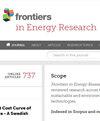Impacts of hydrogen on tropospheric ozone and methane and their modulation by atmospheric NOx
IF 2.6
4区 工程技术
Q3 ENERGY & FUELS
引用次数: 0
Abstract
Atmospheric hydrogen concentrations have been increasing in recent decades. Hydrogen is radiatively inert, but it is chemically reactive and exerts an indirect radiative forcing through chemistry that perturbs the concentrations of key species within the troposphere, including ozone. Using the atmospheric version of the United Kingdom Earth System Model, we analyse the impact of 10% increased surface concentrations of hydrogen on ozone production and loss. We also analyse the impact of this hydrogen in atmospheres with lower anthropogenic emissions of nitrogen oxides (80% and 30% of present-day anthropogenic surface emissions), as this is a likely outcome of the transition from fossil fuels towards cleaner technologies. In each case, we also assess the changes in hydroxyl radical concentration and hence methane lifetime and calculate the net impact on the hydrogen tropospheric global warming potential (GWP). We find that the hydrogen tropospheric GWP氢气对对流层臭氧和甲烷的影响以及大气中氮氧化物对它们的调节作用
近几十年来,大气中的氢浓度一直在增加。氢是辐射惰性气体,但它具有化学反应活性,并通过化学作用产生间接辐射强迫,扰动对流层中包括臭氧在内的关键物种的浓度。我们利用联合王国地球系统模式的大气版本,分析了地表氢浓度增加 10%对臭氧产生和损失的影响。我们还分析了这种氢气在氮氧化物人为排放量较低(占目前人为地表排放量的 80% 和 30%)的大气中的影响,因为这是从化石燃料向清洁技术过渡的可能结果。在每种情况下,我们还评估了羟基自由基浓度的变化,从而评估了甲烷的寿命,并计算了对氢气对流层全球升温潜能值(GWP)的净影响。我们发现,随着地表人为氮氧化物排放量的减少,氢气对流层全球升温潜能值(GWP100)的变化相对较小(目前和 30% 的人为排放量分别为 9.4 和 9.1)。因此,目前对氢气 GWP100 的估计值可适用于未来不同氮氧化物的情况,尽管这一结论可能会受到未来其他活性物种排放量变化的影响。
本文章由计算机程序翻译,如有差异,请以英文原文为准。
求助全文
约1分钟内获得全文
求助全文
来源期刊

Frontiers in Energy Research
Economics, Econometrics and Finance-Economics and Econometrics
CiteScore
3.90
自引率
11.80%
发文量
1727
审稿时长
12 weeks
期刊介绍:
Frontiers in Energy Research makes use of the unique Frontiers platform for open-access publishing and research networking for scientists, which provides an equal opportunity to seek, share and create knowledge. The mission of Frontiers is to place publishing back in the hands of working scientists and to promote an interactive, fair, and efficient review process. Articles are peer-reviewed according to the Frontiers review guidelines, which evaluate manuscripts on objective editorial criteria
 求助内容:
求助内容: 应助结果提醒方式:
应助结果提醒方式:


